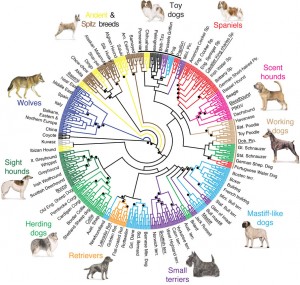I get why some people want a pure breed dog, but I think mixed breed dogs are so very much more interesting.  Check out this great campaign the shelter, Territorio de Zaguates, in Costa Rica started to get people to appreciate the incredible uniqueness of mixed breed dogs.  So cool!
Pre-Columbian Dogs In North & South America
(image via Saving Carolina Dogs Rescue & Adoption Network)
Folklore says that Carolina Dogs predate Columbus, and a recent study shows these stories may actually be true.  Carolina Dogs, Chihuahuas, Peruvian Hairless Dogs, & Mexican Hairless Dogs are missing certain gentic markers that link them to European dogs,  Instead, these breeds share markers with East Asian dogs indicating they descend from dogs that crossed the “Ice Age land bridge known as Beringia some 12,000 years ago” and are much older breeds than most dogs in the Western Hemisphere.  (You can also check out the original study, which goes into greater detail.)
By the way, I love learning new words and here’s a useful one when talking about stray, feral, or Rez dogs—“landrace“, which means:
a local variety of a domesticated animal or plant species which has developed largely by natural processes, by adaptation to the natural and cultural environment in which it lives. It differs from a formal breed which has been selectively bred deliberately to conform to a particular formal, purebreed standard of traits. Landraces are usually more genetically and physically diverse than formal breeds.
Further:
Landraces are not all derived from ancient stock unmodified by human breeding interests. In a number of cases, most commonly dogs, domestic animals have reverted to “wild” status by escaping in sufficient numbers in an area to breed feral populations that, through evolutionary pressure, form new landraces in only a few centuries.
Participate In Megaesophagus Research Project
Hey!  You can help further the research into finding the genetic marker for megaesophagus.  If your dog was diagnosed with megaesopgagus before 1 year of age, you can help by sending in a sample of his DNA.  You’ll need to request a kit busing the contact information in the link. You don’t need to be in the US to participate.  The study is headed up by Leigh Anne Clark Ph.D out of Clemson University.
Check this post to find out more about megaesophagus, where to get support, Bailey chairs, etc.
Friday Fun: The Puppy Love Child
Dogs From Middle East Not East Asia
Evolutionary Tree of Dog Breeds & Grey Wolves
(click to enlarge)
A comprehensive new study shows that dogs are more closely related to wolves in the Middle East and therefore originated there. (It was previously believed dogs were more closely related to wolves in East Asia and originated there.) These new findings better match archaeological evidence of dogs in the Middle East. It’s not all that surprising that dogs originated in the Middle East—this is also where cats were domesticated and many of our livestock animals were domesticated.
The study also showed that dog classifications based on behavioral traits (herding, retrieving, vermin hunting, etc.) match the branches in the dog evolutionary tree. Herding breeds descend from other herding breeds, retrievers from retrievers, sight hounds from sight hounds, terriers from terriers. This seems like common sense, but scientists didn’t have genetic proof before this study. On the flip side, toy dogs, bred for size and not behavioral traits, descend from many branches of the dog evolutionary tree.
Be sure to click on the the dog evolutionary tree above—very interesting.





